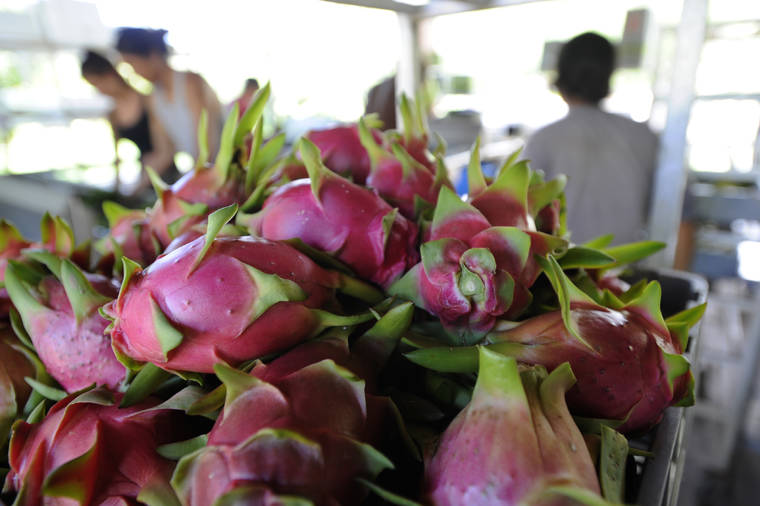The City Council has appropriated $5 million in the city’s operating budget meant to increase local food production, and it’s a much-needed source of funding for farmers.
Earlier this month the City Council approved its $2.9 billion operating budget for the upcoming fiscal year and set aside $5 million for an agricultural grants program for Oahu farmers.
The funding will come from the federal American Rescue Plan Act.
Initially only $1 million was appropriated for the program, but the amount jumped to $5 million at the urging of Councilwoman
Esther Kia‘aina.
Kia‘aina took inspiration from a $2.5 million agricultural grants program in Maui County that awarded as much as $25,000 to more than 100 farmers who were ready to expand and increase production.
She said local farmers — there are about 930 of them on Oahu, according to a 2017 count by the U.S. Department of Agriculture — need the money to pay for equipment, land and water among a long list of other expenses, and said the city hasn’t done much to help them.
“I’ve been very concerned about the availability of funding for our farming community,” Kia‘aina said. “If we, as political leaders, keep on talking about economic diversification and food security and … the importance of agriculture, what are we doing beyond talking about it?”
The rollout of the program, to be administered by the city’s Office of Economic Revitalization, is still underway. One of the decisions
to be made is whether the awards will be up to $25,000, as was the case for Maui County, or if Oahu farmers could be awarded up to $50,000.
Food Security and Sustainability Program Manager Dexter Kishida said the city will have a clearer picture of what the program will look like in mid-July, but the funding is in part supposed to help the city and state become more food resilient and less dependent on food imports.
The state currently brings in as much as 90% of its food.
Experts have said that the $5 million intended to go directly to growers will boost local food production.
“I can go from land to water, labor, transportation, invasive species, food safety — tons of different issues and ways that this grant can help. It really depends on the farmer,” said Brian Miyamoto, executive director of the Hawaii Farm Bureau.
Many agricultural operations are ready to expand and contribute, directly or indirectly, to increase local food production while also providing the city and state with a non-tourism revenue source — another reason stakeholders want to invest in local agriculture.
A recent state-level
$1.5 million agricultural grants program, administered by the state Department of Agriculture and the University of Hawaii at Manoa’s College of Tropical Agriculture and Human Resources, also meant to increase local production and awarded six operations $250,000 each for their projects.
But “they probably received over two or three hundred proposals (from) people who were ready to expand their operations,” according to Saleh Azizi, a farmer and community development coordinator at Kahumana Organic Farms. “There’s tons of people who need funding.”
AgHui, a group of agriculture stakeholders, also has identified nearly 120 “ready to grow” agriculture projects in the state.
Of those, 43 are on Oahu, and the entities involved
are asking for a total of
$31.3 million in funding. Together the projects could net the state an estimated $36.2 million in additional annual revenue.
Many of those projects, however, appear to be
beyond the scope of the
$5 million grants program, but they illustrate the funding needs for local agricultural operations.
One indirect part of local food production that’s gained prominence, especially during the COVID-19 pandemic, has been the role of food hubs, which have become a priority for experts.
While Kia‘aina and Kishida said they are not targets for the grant program, food hubs helped coordinate smaller farmers — 76% of Oahu farms are smaller than 10 acres, and 91% are smaller than 50 acres; and handled the distribution, packaging and marketing of farm products, allowing farmers to focus on farming.
“Instead of a farmer buying a 20- or 40-foot refrigerated container, which is anywhere from $5,000-$25,000, they could pick (vegetables) … and then they could sell it to the food hub,” said Vincent Kimura, founder and CEO of Smart Yields. “And the food hub could then deliver it to farmers markets, CSAs (community-supported agriculture), restaurants and other businesses or … ‘value-add’ it, which is to puree it, dehydrate it, cook it.”
Azizi, who earned a doctorate at UH Manoa’s Department of Urban and Regional Planning, authored an article in March showing that the sales of 11 food hubs from around the state jumped nearly 200% from before March 2020 and after June 2020.
The article found that
the annual revenue for the food hubs was $3.3 million prior to the pandemic and
$9.8 million afterward, and “some hubs increased as much as ten times in sales, hiring, and purchases.”
Even though the biggest buyers of local produce, including hotels and restaurants, shut down during the coronavirus pandemic, food hubs helped farmers pivot to selling directly to consumers.
The hope for stakeholders is that the city’s $5 million grants program leads to more consistent funding for local agriculture operations.

